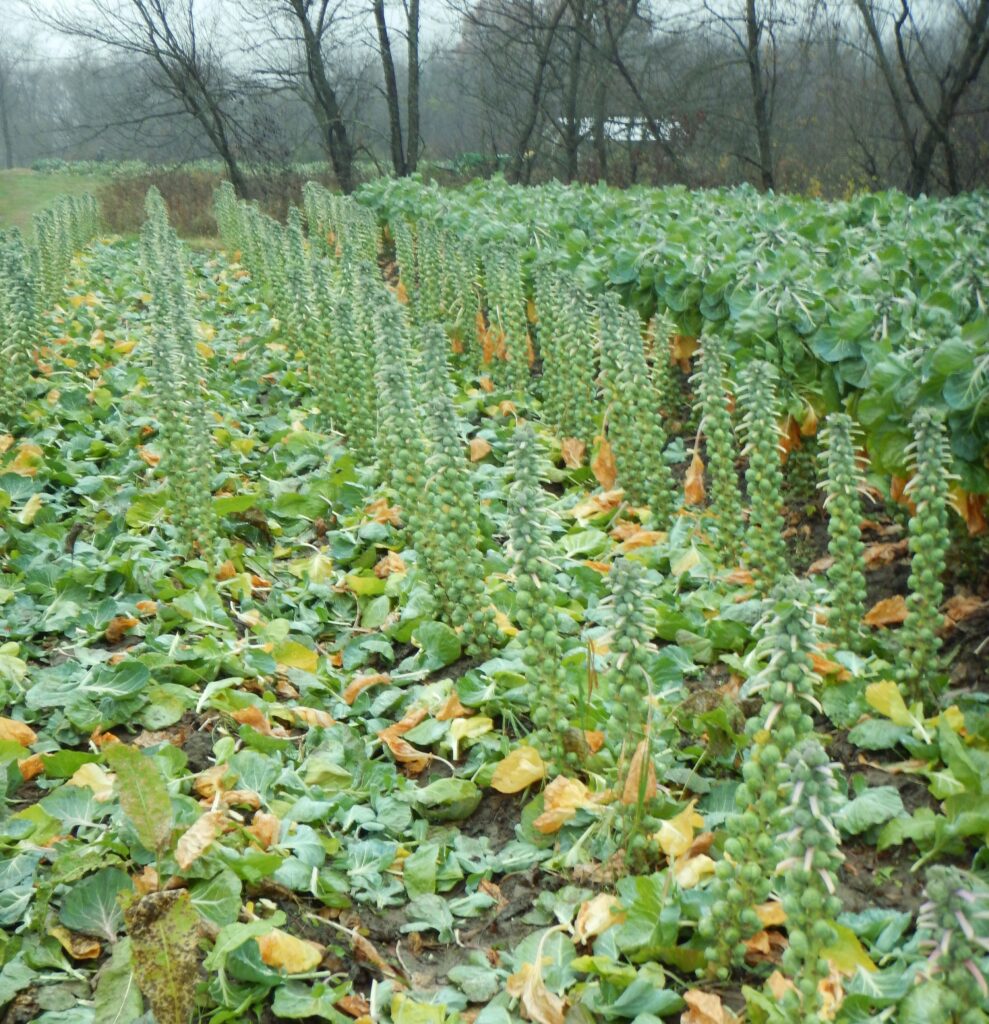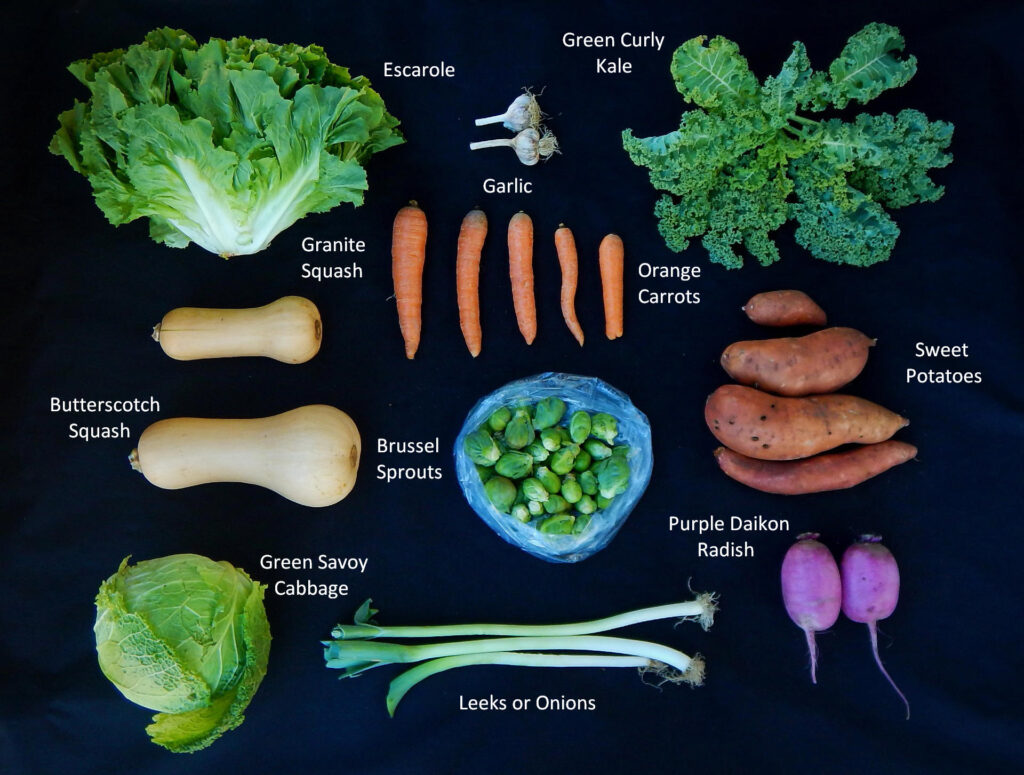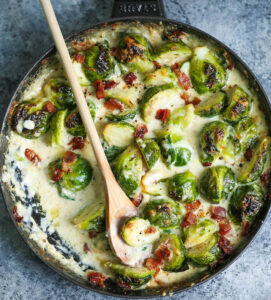What’s In The Box with Recipe Suggestions
Brussels Sprouts: You can either cook them whole or cut them in half if you prefer. Larger sprouts should be halved or quartered before cooking. You may store fresh Brussels sprouts in the refrigerator in the plastic bag we packed them in. They should be good for at least 2-3 weeks. Some of the outer leaves may start to yellow, but you can easily trim those away.
Maple Gochujang Roasted Brussels Sprouts
Green Savoy Cabbage: The term “savoy” refers to the curly texture of the leaves on this cabbage. This cabbage is good for eating raw or cooked. It is a storage variety, so you can store it for several weeks in the refrigerator, loosely wrapped in a plastic bag to keep it from dehydrating.
Sheet Pan Roast Chicken and Cabbage
Orange Carrots: Carrots are an important part of our diet for much of the season, but we rely on them for important nutrients and culinary contributions especially in the winter! Incorporating them into your diet throughout the week is health insurance! Challenge yourself this winter to see how many different ways you can find to incorporate carrots into your meals!
Italian Garlic: Garlic cloves are great when poached in olive oil, also known as confit. The garlic softens and becomes sweet and caramelized while the oil is infused with garlic essence.
Mashed Potatoes with Garlic & Horseradish
Green Curly Kale: This is a perfect time of the year to eat kale. It’s been kissed by several nights of frost which makes it sweet and tasty! Use it raw to make a salad or turn it into baked kale chips. You can also use it in soups, stews, gratins and hot dishes.
Parmesan Broth with Kale and White Beans
Leeks or Yellow & Red Onions: This is the last chance for leeks, and we didn’t have enough for all the boxes. Some of you will receive leeks, while the rest will receive yellow & red onions.
15 Minute Creamy Leek and Mushroom Pasta
Roasted Beet, Caramelized Onion & Goat Cheese Tart
Red Onion & Blood Orange Salad
Purple Daikon: Daikon will store for several weeks in your refrigerator as long as you don’t let it get soft, and if it does get soft, put it in a soup or stew.
Caramelized Pork Bahn Mi with Pickled Carrots & Daikon
Spicy Roasted Daikon Radish French Fries
Covington Sweet Potatoes: The optimal storage temperature for sweet potatoes is 50-60°F. If you don’t have an environment at that temperature, we recommend storing them at room temperature in your home. Do not refrigerate them and be careful if storing them in a garage as the temperature may drop too low in the winter.
Sweet Potato Bread with Dates & Cranberries
Sweet Potato Kale Salad with Creamy Honey Mustard Dressing
Escarole: This vegetable resembles a head of leaf lettuce, but it is actually a bitter green in the chicory family. And don’t be deterred by the description of “bitter.” We intentionally harvest escarole late in the season after it has been through several frosts as the cold treatment makes the flavor milder and more well-balanced. You may notice some browning on the edges of some of the leaves. This is a touch of frost damage. Simply remove that portion of the leaf before using.
Wilted Escarole with Feta, Walnuts & Honey
Escarole & Goat Cheese Pizza with Honey-Toasted Walnuts
Butterscotch and Granite Butternut Squash: Butternut is possibly the most popular variety of winter squash in the US and a quick search on the internet will turn up thousands of recipes! Store this squash at room temperature or in a cool environment between 45-55°F for optimal shelf life. You can either bake it with the skin on and scoop the flesh out after it’s cooked, or peel it prior to cooking.
Butternut Squash & Cranberry Quinoa Salad
Roasted Butternut Squash Apple Burrata Pizza
Vegetable Feature:
Brussels sprouts are a popular crop many members have come to adore when they realize how delicious they are when harvested fresh in the peak of their season (after they are frost-kissed) AND cooked properly. Brussels sprouts are another selection in the family of Brassicas which include cauliflower, broccoli, and cabbage. They resemble little cabbages and grow on stalks with leaves similar to collards. We start Brussels sprouts from seed in the green house in the spring and then plant the transplants to the field where they require a 4–6-month growth period to reach their full potential.

There are several points that are very important when it comes to Brussels sprouts. First, frost and cold temperatures contribute significantly to the eating quality of Brussels sprouts. After the frost ‘kisses’ the sprouts, the flavor of the sweetens and becomes slightly nutty, and pleasant. California is a major Brussels sprouts producer for the United States. While Brussels sprouts do grow well there, there are many who are of the opinion that the mild California coastal climate just isn’t quite cold enough for a great Brussels sprout. Thus, consider yourself lucky that you live in Wisconsin & Minnesota where we can grow some delicious, sweet sprouts!
The second point of importance is DO NOT OVERCOOK THEM! When the color fades from bright green to a dark olive color, the flavor fades too. Overcooked Brussels sprouts go from crisp & tender to soft and mushy in texture and their sweetness is traded for a strong, unpleasant flavor with a pungent smell to accompany it. Larger sprouts should be cut in half or par cooked if left whole. Smaller sprouts may be left whole or cut in half. When you are ready to use them, simply trim the end and remove any spotty leaves. Rinse and then you are ready to use them. They can also be shredded by cutting them in half and putting the cut side down and slicing them thinly with a knife. Brussels sprouts may be sautéed, roasted, or lightly steamed just until the color is bright, and they are tender to slightly al dente. While most frequently cooked, Brussels sprouts may also be eaten raw. This week’s boxes include 1 pound of Brussels sprouts. One pound of Brussels sprouts is equal to about 4 cups halved.
Brussels sprouts pair well with smoky and salty foods including bacon, ham, aged or sharp cheese, and blue cheese. Additionally, preparations often include mustard, walnuts, pecans, lemon juice, onions, and garlic.
They are definitely worth eating from a nutrition standpoint. They are high in fiber, folate, magnesium, potassium, and vitamins A, C, and K and are packed full of powerful, cancer-preventing properties as well. Store your Brussels sprouts in the fridge in the bag we packed them in. You should open the bag a bit though and let them breathe.
Short & Sweet Weekly Farm Update
So far, we have said Goodbye (goodbye until spring) to 10 crew members that returned home to Mexico for the winter. That is the first sign we are making the shift (no stopping Mother Nature) into the winter season. We have made progress in the field and all the garlic for next season is planted and ready for mulch. We use our rye mulch bales that we bale from our cover crop plantings to insulate the garlic in the cold winter months. This is also useful to keep the weeds at bay, we never fully stop them, but the mulch makes it more manageable.
We are still harvesting rutabaga, turnips and storage radishes from the fields. We have smaller amounts of parsnips, sunchokes and horseradish to dig. We will also leave some of them in the field to overwinter in the field. We do have to fence these crops to keep the deer out. The deer hooves are quite effective at digging in through the frosted ground to eat those vegetables. We should be flattered that they can’t stay away, but it does create a problem when we both want to eat the same vegetables, so we have to keep them out!
There are no vegetable boxes next week, as we plan and deliver our beef and pork packages. We still have plenty of pork packages and pork a-la-carte items available for our December delivery. See your email for more details.



